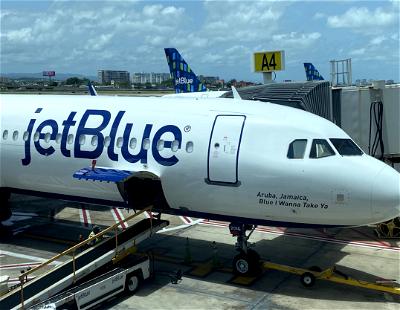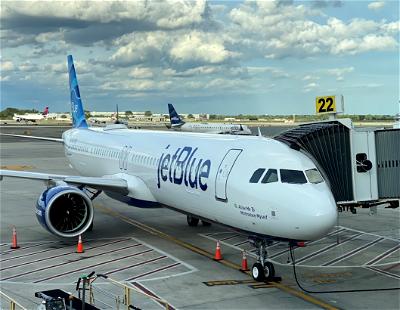Here’s something that’s pretty rare, but not unheard of…
In this post:
JetBlue A321 tips backwards after arriving in New York
This incident happened on Sunday, October 22, 2023, and involves a seven-year-old JetBlue Airbus A321 with the registration code N959JB. The aircraft had just arrived from Bridgetown, Barbados (BGI), having operated flight B6662. The plane was at the gate, and passengers and cargo were in the process of being removed, when the aircraft tipped on its tail.
You can see the video of the incident for yourself below…
Fortunately there aren’t any reported injuries, because as you’d expect, this could pose a risk to both the passengers and crew on the plane, as well as ground staff. The aircraft has been taken out of service, though, and it remains to be seen for how long it won’t fly (odds are that the damage wasn’t too bad, but at a minimum, a close inspection is needed).
How can planes “tip” backwards like this?
It’s pretty rare to see incidents like this occur, which is why something like this makes headlines. What could cause a plane to tip backwards, as seen here? While I’m sure an investigation will be performed, presumably this comes down to weight and balance.
While with normal procedures the plane wouldn’t tip, just enough went wrong that it became an issue:
- Luggage is seemingly being removed through the forward cargo door, so maybe a lot of weight had already been removed there, while there was a significant amount of cargo in the rear
- Passengers disembark front to back, so perhaps passengers weren’t moving forward that quickly
This was probably the perfect storm in terms of having too much cargo and passenger weight in the back of the aircraft, while not having enough cargo and passenger weight in the front of the aircraft.
Among mainline jets, the 737-900 is generally considered to be most at risk of tipping backwards on its tail, which is why many airlines have a tail stand that they use for the aircraft. Essentially this is a stand placed near the back of the aircraft that prevents tipping.
While the A321 is the longest variant of the Airbus A320-family of aircraft, the plane historically hasn’t been as prone to tipping as the 737-900.
Bottom line
A JetBlue Airbus A321 had a rough Sunday night, as it tipped on its tail after landing from Barbados. One assumes that this came down to a weight and balance issue, and there not being enough weight in front of the aircraft, and there being too much weight in the back of the aircraft.
This is rare, but not unheard of. However, incidents like this are most common with the 737-900, and not the A321.
What do you make of this JetBlue Airbus A321 incident at JFK?





This is due to the ground crew not off-loading the aircraft properly. Plain and simple. Look at the load plan(supervisor). The A321 has excellent CG. Either they started offloading significantly after deplaning started or they simply emptied the front hold first.
Yo' momma's so fat, that when everybody else got off a jetBlue flight...
Proof of how over weight Americans are. Too many Super Sized orders at the airport.
It's always a rule, don't offloaded the front end of AB or any tail heavy plane regardless of what type. It's not only AB's, there are pics of DC-10's doing the same thing, as loading aft first will do the same thing.
I have seen that probably all Alaskan Airlines 737s at Sea-Tac Airport have tail stands as standard protocol. Is this based on airline decision / risk management?
For year many B6 GO crew members spoke of this issue with B6 management and went on dead hears. This issue caused have been avoided but was ejected, due to never happing.
Right, blame management because you aren't doing your job properly.
In a previous life I worked Load Control (weight-n-balance) for AA
The 727-200 had an arrival limitation :
If there was more than 5000lbs loaded in the aft cargo hold (rare)...
And the planned arrival fuel was less than 18,000lbs (common)...
Then passengers could not be let off until sandbags were added into the forward hold.
I was told it was due to the 3 engines being aft mounted. That plus...
In a previous life I worked Load Control (weight-n-balance) for AA
The 727-200 had an arrival limitation :
If there was more than 5000lbs loaded in the aft cargo hold (rare)...
And the planned arrival fuel was less than 18,000lbs (common)...
Then passengers could not be let off until sandbags were added into the forward hold.
I was told it was due to the 3 engines being aft mounted. That plus a heavy load aft meant that we NEED the passengers ahead of the wing to balance it.
IMHO, 'stretch' aircraft models (like the 727-200 & A-321) tend to be a little more touchy. The see-saw effect.
And, for av-geeks, what about tail-dragging on takeoff? The tail angle on most airlines is about 15 degrees. The departure angle is typically 15 degrees. Tech manuals typically state that once an aircraft reaches rotation speed, rotation is typically 3 degrees per second for 5 seconds to achieve that 15 degrees. Rotation consumes 1000 feet of runway. Near the end of that rotation, the wheels are off the ground and the tail is clear. At...
And, for av-geeks, what about tail-dragging on takeoff? The tail angle on most airlines is about 15 degrees. The departure angle is typically 15 degrees. Tech manuals typically state that once an aircraft reaches rotation speed, rotation is typically 3 degrees per second for 5 seconds to achieve that 15 degrees. Rotation consumes 1000 feet of runway. Near the end of that rotation, the wheels are off the ground and the tail is clear. At that point, the pilot chooses a rate of climb. Staying at the 15 degrees, you're typically looking at about 2000 feet per minute.
I believe I read that pilots get immediate feedback after every successful 321 takeoff reporting the rotation angle. The unsuccessful takeoffs are apparent without feedback.
Sorry Guys, It's me. I was sitting in the back of the plane....
Always been rather surprised that we don't see more airlines using tail-stands for A321s. Wonder if B6 will be from now on...
Many carriers that operate the A321 require a tail stand while loading or unloading.